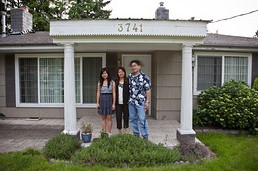
Good Schools, Bad Real Estate
usinfo | 2012-12-27 15:40
Kiely and John Adams began their house hunt this spring with grand plans to upgrade from their small home in Cary, N.C., to a larger, four-bedroom house—preferably with an office and a bonus room—about 25 miles away in Chapel Hill, where Kiely plans on starting a Ph.D. program next fall.
They could have gotten all that and more for their $415,000 budget if they kept their search on the outskirts of Chapel Hill. But, determined to stay within the boundaries of Chapel Hill's highly-regarded school district, the parents of 5-year-old twins, Megan and Bevin, and 4-year-old Sean trudged ahead in what they dubbed "an exercise in compromise." Even when they did find a house that showed promise, it was usually snapped up before they could take a closer look. "Most houses seemed to come and go, come and go," Mr. Adams says.
One Family, Two Houses

Amanda Koster
The Shin family bought this smaller house in Bellevue, Wash., just to get their daughter into the school district.
It's supposed to be a buyer's market. Yet, for parents determined to buy in areas associated with top schools, those bargains may be harder to come by. When housing markets go south, "areas with exceptional schools tend to hold their value better than the market overall," says Michael Sklarz, president of Collateral Analytics, a Honolulu-based firm that specializes in real estate data analysis.
In Chapel Hill, where the Adams family was looking, the average single-family home price, based on price per square foot, has declined about 4.8% since the market peaked in 2007, according to Collateral Analytics, but houses there still command about a 48% premium, per square foot, to homes in the Raleigh-Cary metro area.
In other parts the country, home prices have dropped in areas with good schools, but the declines are typically nowhere near the levels in their surrounding metro areas. In Irvine, Calif., a city that regularly gets national attention for its quality schools, average price per square foot has fallen 18% since its 2006 peak, but prices in the greater metro area surrounding Irvine fell 33%. The same goes for Edina, Minn., where prices per square foot are down about 14% since their peak, versus 27% for the greater Minneapolis area. And in the brainy town of Andover, Mass., prices are down just 4%, versus more than 16% for the Boston metro division.
There are several factors at play, says Mr. Sklarz. Areas with good schools tend to be more affluent and were less susceptible to the sub-prime mortgage debacle so saw fewer foreclosures. What's more, homes associated with great schools generally sell faster, in good markets and bad.
All of this comes as no surprise to the real estate agents who work with education-obsessed parents. "Schools have a huge impact on home values," says Kathy Beacham, a real estate broker in Raleigh. When schools in her own well-to-do neighborhood were redistricted three years ago, the value of her million-dollar home dropped more than $150,000. "A good education has always been important but I don't remember looking at the numbers like parents do today," she says.
Then again, the numbers have never been so widely available. State assessments, independent ratings from websites like GreatSchools and Education.com and annual magazine rankings of America's top high schools have not only made it easy for parents to factor school test scores and parent-teacher ratios into their buying decisions, they've cemented the relationship between home prices and school quality.
When Florida rolled out its statewide grading system in 1999, the real estate market took note. According to research by David Figlio, who is now a professor of education, social policy and economics at Northwestern University, an A-rated school in Gainesville added about $10,000 to the value of a home there versus a B school.
Once a school is graded, the gap often grows. Strong ratings lead to better community support, which in turn leads to better schools. Today, the difference between an A school and B school might easily be $50,000 on a $300,000 house, he says.
That phenomenon isn't lost on residents of Bellevue, Wash., a Seattle suburb that is home to some of the best schools in the state. "I don't think there's ever been a school levy on the ballot here that's been turned down," says broker Michael Orbino. Even residents who don't have school-age children tend to stand behind the schools. It's not altruism; it's economics. All things being equal, homes in the Bellevue school district fetch as much as a 15% premium to those just outside of it, he says.
"But there's more to it than that," says Mr. Orbino. "Because the land is worth so much more in Bellevue, builders tend to build more expensive homes here," making the school district that much more expensive to begin with. By Mr. Orbino's estimate, the prices for single-family homes are down about 10% since the market peak. "But it isn't a catch-all," he says. Prices for ultra-luxury homes and condos, which generally aren't influenced by schools, are down 30% to 40%, he says. So while prices per square foot in Bellevue have fallen slightly more than the Seattle market overall, prices for more family-friendly abodes haven't necessarily seen the same declines.
Share this page



















